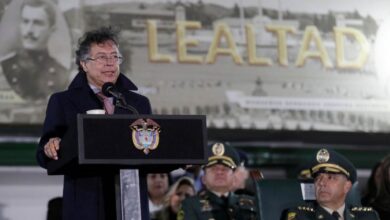With the arrival of Gustavo Petro to the Presidency of that country, more than 100 years of struggle of the left to obtain the highest position in the Executive are concluded .

Photos: Colombia.com, Carlos Pizarro
LatinAmerican Post | Christopher Ramírez Hernández
Listen to this article
Leer en español: Así fue el camino de la izquierda para llegar al poder en Colombia
On August 7, Gustavo Petro became the new president of Colombia, replacing Iván Duque, who had been in power since 2018. However, beyond the change of command or the political enmity that exists between the two politicians, the headline that was read the most in the main national and international media was: "Colombia has the first left-wing president in its history."
Both for Petro and for the Pacto Histórico (the left-wing group that brought him to power), the arrival of progressivism in the Casa de Nariño (presidential headquarters) occurred after several decades of struggles. By this time ideas were not the only component, because the weapons were also protagonists.
The first time the left was heard as a political resource in Colombia was in 1919 with the founding of the Socialist Party, which three years later (1922) also became the first figure from the left to participate in presidential elections. These elections were won by the conservative leader Pedro Nel Ospina, son of Manuel Ospina Rodríguez, founder of said right-wing group in Colombia; and uncle of Mariano Ospina Pérez, who also came to power in 1946, precisely on behalf of the conservatives.
Now, although the Socialist Party never managed to put a president in power, it did have a great impact on the placement of liberal presidents who, although they did not identify themselves as leftist, took into account the progressive ideas of the time for the execution of great social and cultural changes in Colombia.
Thus, in 1930, after a conservative hegemony of 36 years, the liberal president Enrique Olaya Herrera became president. In 1934, he gave his post to his co-party, Alfonso López Pumarejo, considered by many experts as the man who took the first steps of a leftist policy in Colombia, without having to be a militant of said ideology.
With López Pumarejo, what became known as 'The Revolution in March' was developed, a political strategy that, according to records on the official website of the Colombian Presidency, "pointed towards the modernization of the country and its immersion in the sphere of the economy capitalist". In short, this president tried to “give the country an agricultural and industrial development that would allow it to become a modern State” with reforms such as “constitutional, tax, university, judicial, labor and foreign relations.”
However, the reactionary right, led by conservative leaders such as Mariano Ospina Pérez himself and Laureano Gómez (president from 1950 to 1951), did not allow Alfonso López's reforms to have great success, although they did provide great inspiration.
However, it was not until the impact caused by Jorge Eliécer Gaitán, assassinated on April 9, 1948, in the middle of the presidential campaign, that socialist ideas would begin to gain strength in Colombia. The assassination of the liberal leader, whose doctoral thesis was based on "Socialist ideas in Colombia", unleashed a wave of violence that carries its consequences of this day.
The persecution of the radical conservative right, first, against liberal militants, and second against leftist thinkers, gave rise to the first liberal and leftist guerrillas in the country, such as the National Liberation Army (ELN) and the Revolutionary Armed Forces of Colombia (FARC). These groups outside the law were created based on the Marxist-Leninist ideologies present in the former Soviet Union and, of course, in Cuba, whose revolution led by Fidel Castro in the 1950s represented the first great triumphant leftist movement in Cuba. Latin America.
It may interest you: This is How the Relationship Between President Gustavo Petro and the Colombian Armed Forces Begins
However, as León Valencia, a political analyst and former member of the ELN, explained, it was not until the arrival of the M-19 that the left did not see itself as a real change in Colombian society, not starting from arms but from democracy. “I was a central commander and I must admit that those who always had the greatest lucidity at that time to act in democracy were those of the M-19 (…) And history rewarded them, gave them a new president,” Valencia said in conversation with El País of Spain.
This guerrilla group, which was born in the late 1970s, had among its ranks great representatives of the Colombian left such as Carlos Pizarro Leongómez, who signed the Peace Agreement with the national government in 1990, and was assassinated the same year; Antonio Navarro Wolff, one of the members of the Constituent Assembly that gave life to the Political Constitution of 1991, and Gustavo Petro himself, who began his political life in the 1980s under the embrace of the M-19.
Now, special recognition must also be given to the Patriotic Union, a political group launched after the demobilization of several members of the FARC in the mid-1980s. Unfortunately, members of the UP were the target of paramilitary attacks and members of the State, who ended the lives of presidential candidates such as Bernardo Jaramillo and Jaime Pardo Leal, as well as another 8,300 citizens and more than 5,733 disappeared, according to information from the Special Jurisdiction for Peace (JEP), created after the Peace Agreements of 2016.
But it was not until the beginning of the 21st century, when left-wing politicians went from being “second class” characters in national politics, to being the protagonists of great democratic challenges in Colombia. With politicians like the late Carlos Gaviria, who won second place in the 2006 presidential elections, the left managed to begin to break away from the Soviet and Cuban paradigm, to show less communist and more progressive and diverse ideas, which today have served to take into account Petro as the first leftist president in Colombia.





